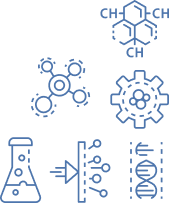
Inorganic Chemistry Homework Help - TutorBin
Submitting quality work on time does not get any easier than this. Choose TutorBin and avail top rated homework help today to maintain a high GPA.

Trusted by 1.1 M+ Happy Students
Seek Inorganic Chemistry Homework Help To Soar Your Grades!
Inorganic chemistry is a vast and complex subject that deals with the properties and behavior of Inorganic compounds, which include metals, minerals, and organometallic compounds. Since organic chemistry is mainly concerned with carbon molecules, inorganic chemistry primarily involves objects that are not living and do not contain carbon. Students occasionally experience some difficulty completing the inorganic chemistry homework given to them. The challenge is remembering so many chemical reactions and exceptions. However, you shouldn't worry because TutorBin has top-notch tutors who can provide you with the best inorganic chemistry homework help!
We offer exceptionally affordable pricing to complete your "Do my Inorganic Chemistry homework" request to stay within your budget. To help you get top scores, our Inorganic chemistry tutors offer precise Inorganic chemistry homework solutions. Isn't that fascinating? If so, continue reading this blog post to discover more about it.
TutorBin: No.1 Online Inorganic Chemistry Homework Help in the USA
| Topics | Benefits |
|---|---|
| Organometallic chemistry | Top-notch quality |
| Transition elements | 0% plagiarism |
| P-block elements | On-time delivery |
| S-block elements | Eminent tutors |
| Acid, bases, and salts | 100% accuracy |
| Crystal field theory | Free revisions |
| Valence bond theory | Pocket-friendly prices |
Topics Our Inorganic Chemistry Tutors Cover!
Our Inorganic chemistry tutors cover the following topics while handling your "Do my Inorganic Chemistry homework solutions" request.
- Organometallic Chemistry
- Transition Elements
- P-Block Elements
- S- Block Elements
- Coordination Number
- Acid, Bases, and Salts
- Crystal Field Theory (CFT)
- Valence Bond Theory
- Chemical Bonding
When To Seek Inorganic Chemistry Homework Solutions?
Anytime you can seek Inorganic chemistry homework help from experts. Asking for homework help is not restricted to a particular time. Some students wait until the very last moment to ask for our help. However, we advise that you contact us as soon as possible. But how can you tell if you need help with Inorganic chemistry homework? Here are several indicators that your homework ought to be handled by a professional:
- Your lack of conceptual understanding restrict you from providing the high-quality work that your teacher expects.
- You lack time to research thoroughly and produce accurate Inorganic chemistry homework solutions.
- You cannot find Inorganic chemistry reference books that provide the detailed information necessary to finish the homework accurately
- You have personal emergencies and can't find time to complete tedious and time-consuming homework.
We at TutorBin are aware of your situation. We aim to assist you with your Inorganic chemistry homework regardless of your circumstances.
TutorBin Can Satisfactorily Handle “Do My Inorganic Chemistry Homework” Request!
At TutorBin, we have a pool of experts with years of experience in assisting students with their inorganic chemistry homework. We make every effort to ensure that you finish your project on time and receive excellent scores. When you ask for our help, you get it from a qualified, seasoned homework tutor with a track record of delivering exceptional work. The following are some reasons for using our Inorganic chemistry homework assistance:
- Prompt and efficient: Some teachers are overly strict with their students regarding due dates for homework. Therefore, we ensure that you receive assistance on time, never miss the deadline, and receive the highest possible grades for your project. Inorganic chemistry homework writing is a specialty of our team. We know reliable information resources and do tasks on schedule without sacrificing quality. Once you ask for our help, have faith that you will meet the submission deadline.
- A competent professional will do your homework: When you ask, "Can I pay someone to do my Inorganic chemistry homework?" We choose the most qualified professional to help you. This person is qualified and aware of what your teacher expects. They will create a paper to persuade the teacher to give you the highest grade.
- Easily accessible service: We're available and prepared to assist you with your Inorganic chemistry homework anytime. We know that sometimes you need emergency help at odd hours to complete your task. For that reason, we are easily accessible to help you in an emergency. You can ask us to finish your Inorganic chemistry homework at any unexpected time. Our company offers dependable and expert service.
- Guaranteed quality: We know how important quality is in achieving perfect grades. Because of this, we will never compromise on quality.When you ask for our assistance, we deliver your work following the highest standards. Your Inorganic chemistry homework will undergo careful quality checks before we give it to you.
- Free Revision: If you feel that the quality of your homework is not quite what you were hoping for, you can call us immediately. Our online Inorganic chemistry tutor will conduct free revisions for you.
- Original material with a thorough explanation: Our work has no traces of plagiarism. Our experts will carefully examine your Inorganic chemistry homework solutions. You may be sure that the Inorganic chemistry answers you receive from us will help you comprehend all the fundamental concepts.
- Prices are reasonable: Our main objective is to support students' academic growth, and we strive to offer affordable fees to fulfill everyone's demands. Our service costs are fair. As long as TutorBin is responsible for providing Inorganic chemistry homework solutions, you won't feel under any financial burden.
Call Us Now To Avail Of Inorganic Chemistry Homework Help!
When solving your Inorganic chemistry homework, do you often end up getting an incorrect solution? Are you concerned that you might not finish your Inorganic chemistry homework answers in time? End your concerns because TutorBin now offers excellent Inorganic chemistry homework help. We provide 100% original and precise Inorganic chemistry homework help. Our eminent Inorganic chemistry tutors have made it possible. We carefully check their educational background, work experience, and general skill level before hiring them.
We provide quality Inorganic chemistry homework assistance at a reasonable price and promise that you will always get our round-the-clock service. Not just that, we assist with Inorganic chemistry homework at all levels and in the format you require. What are you waiting for if you want service from the Inorganic chemistry homework help team? Make the proper choice and call us immediately to take advantage of some fantastic perks, offers, and rewards on our Inorganic chemistry homework assistance. Don't blow the opportunity or regret it afterward!
Popularly Searched FAQs By Students!
Does TutorBin provide Inorganic chemistry homework help for free?
Our Inorganic chemistry specialists are knowledgeable and capable. We do not provide free Inorganic chemistry homework help since we pay our tutors for their time and effort. However, since the cost is fair, there is no need to worry.
How long will it take to provide help with Inorganic chemistry homework?
We advise setting a deadline so that we can make sure you get your Inorganic chemistry homework assistance on time. The difficulty level and due date of your Inorganic chemistry homework will decide how long it takes to complete.
How much do your Inorganic chemistry tutors charge for providing step-by-step homework solutions?
Several factors determine our Inorganic chemistry tutors' charges for giving step-by-step homework help. These are
- The subjects
- Length of the homework
- The difficulty of the question
- Proximity to the deadline
Where can I get the Inorganic chemistry help online?
When you search for Inorganic chemistry homework help on Google, it displays several options. Before hiring someone to finish your Inorganic chemistry homework, keep the following things in mind:
- A short turnaround time
- Quality assurance
- Eminent tutors with experience
- Affordable prices
TutorBin satisfies all of these requirements to aid in your academic success. We help you complete your Inorganic chemistry solutions accurately and on time.
Can I get plagiarism-free Inorganic chemistry solutions?
Plagiarism is associated with poor academic grades. Our tutors are aware of the repercussions of turning in copied work. Our distinguished instructors follow the following guidelines to avoid plagiarism when providing Inorganic chemistry homework solutions:
- Cite your sources correctly.
- Proofread and edit the paper. Make effective use of quotations and paraphrases.
Can you help me do my Inorganic chemistry homework?
Yes! To fulfill your "do my Inorganic chemistry homework" request, follow these steps:
- For trustworthy assistance with your Inorganic chemistry homework, turn to TutorBin.
- Please indicate if you need live instruction, video answers, or online Inorganic chemistry homework assistance.
- Create a free account and post your request for help with your Inorganic chemistry homework. For the most outstanding Inorganic chemistry homework assistance, don't hesitate to contact us at 7082686818 or tutors@tutorbin.com.
- Pay your tuition fee and select a qualified Inorganic chemistry teacher.
- You're prepared to ace your Inorganic chemistry homework with a professional's help.
Why is TutorBin the best online Inorganic chemistry question solver?
TutorBin is an excellent online resource for answering Inorganic chemistry questions because it has many features.
- You can use our video solutions to find answers to challenging Inorganic chemistry questions.
- Get professional support around the clock.
- We provide 100% original Inorganic chemistry homework solutions on time.
- For better understanding, obtain accurate and thorough Inorganic chemistry solutions from Tutorbin.
- Until you are satisfied with the results, we will make as many free revisions to your Inorganic chemistry homework as necessary.
- We promise to keep you completely anonymous.
- You can quickly enlist the assistance of our Inorganic chemistry tutor as our tuition fees are the bare minimum.
- You can receive rewards, savings, and exclusive offers from TutorBin.
Recently Asked Inorganic Chemistry Questions
Expert help when you need it- Q1: 3 - Names of Molecular Compounds(5pts)Complete the table with the name for the compounds. (18pts)Complete the molecular compound structure table and upload an image of the completed table here. See Answer
- Q2: Which of the following correctly places the ligands in their order in the spectrochemical series? Da.F-< Cl-<H2O<NH3 b.CI-< Br-< NH3 < H2O OCI-< Br-<NH3 < H2O Od. Br-<I-< phen<H20 De.1-< Cl¯<H20< enSee Answer
- Q3: Match the hybridisation to the numberedcarbon atoms in the following molecule: See Answer
- Q4: Explain the difference in the boiling points(B.p.) for the following molecules which have similar molecular mass. See Answer
- Q5: Which of the options listed below is the correct IUPAC name for the following molecule. Select one: a. 6-ethyl-4-methylhept-2-ene b. The correct IUPAC name is not listed. c. 6-ethyl-4-methylhept-2-yne d. 2-ethyl-4-methylhept-5-yne e. 4,6-dimethyloct-2-yne f. 3,5-dimethyloct-6-yneSee Answer
- Q6: Match the numbered carbon atoms to the hybridisation present on those atoms in the following molecule: See Answer
- Q7: Which of the following Newman projections represents the least stable (highest energy)conformer of 1,2-dibromoethane? Select one: a. A is the least stable conformer b. B is the least stable conformer c. C is the least stable conformer d. D is the least stable conformer e. E is the least stable conformerSee Answer
- Q8: Which of the options listed below is the correct IUPAC name for the following molecule, which is an explosive and has been associated with a number of deaths when used as a dieting aid. Select one: a. 2,4-dinitrophenol b. 2,4-dinitrophenoxide c. The correct IUPAC name is not listed d. 1-hydroxy-2,4-dinitrobenzene e. 1,3-dinitrophen-4-ol f. 2,4-dinitrotolueneSee Answer
- Q9: How many isomers are possible for an alkene that has a molecular formula of C4H7Br?{Hint: the best way to approach questions like this is to draw the carbon frameworks and then attach the bromine atom in the unique positions in each of these frameworks.}See Answer
- Q10: Drag and drop the appropriate label with the 4 functional groups present in the following molecule. Align the "crosshair" of the label directly over the functional group. (2 marks) See Answer
- Q11: From the options below identify the major(largest amount formed) product for the following reaction: Select one: See Answer
- Q12: Determine the absolute configuration (R or S)of the following molecules. See Answer
- Q13: Match the given reactions to the type of reaction they represent. See Answer
- Q14: Which of the following medical complexes has a square pyramidal geometry? technescan MAG3 cardiolite carboplatin O cisplatin O BBR3464See Answer
- Q15: Which of the following ligands is not a chelating agent? oxalato O protoporphyrin(IX) trimethylphosphine O bipyridine ethylenediamineSee Answer
- Q16: Consider the diagram shown below for a dimetallic complex. Which of the following statements is not true regarding this structure? Contains two bridging ligands. Contains ligands derived from cyclopentadienyl. Contains ligands derived from the phosphine molecule. The complex is a derivative of ferrocene. O Contains ligands in an eclipsed conformation.See Answer
- Q17: A characteristic of all ligands is that they are: O anions electron pair accceptors O Lewis acids neutral molecules Lewis basesSee Answer
- Q18: Which metal complex ion is expected to be subject to a Jahn-Teller distortion? \text { a. }\left[\mathrm{Cr}\left(\mathrm{NH}_{3}\right)_{6}\right]^{2+} \text { b. }\left[\mathrm{Cr}(\mathrm{en})_{3}\right]^{3+} \text { C. }\left[\operatorname{Cr}\left(\mathrm{H}_{2} \mathrm{O}\right)_{6}\right]^{3+} \text { d. }\left[\mathrm{Cr}(\mathrm{CN})_{6}\right]^{3-} \text { e. }\left[\mathrm{Cr}(\mathrm{bpy})_{3}\right]^{3+}See Answer
- Q19: In which complex ion does the metal possess a do configuration? a. [CoCla1?- P. [MNF612-nF6] C. [Ni(H2O)6]2+ d.[Fe(CN)6]3- - ]3-[CFF6]See Answer
- Q20: What is the best name for the coordination compound with formula Na2[PdCl6]? O disodium hexachloropalladium(IV) sodium hexachloropalladate(IV) disodium palladium(IV) hexachloride sodium hexachloropalladium(IV) disodium hexachloropalladate(IV)See Answer
Popular Subjects for Inorganic Chemistry
You can get the best rated step-by-step problem explanations from 65000+ expert tutors by ordering TutorBin Inorganic Chemistry homework help.Get Instant Inorganic Chemistry Solutions From TutorBin App Now!
Get personalized homework help in your pocket! Enjoy your $20 reward upon registration!
Testimonials
TutorBin has got more than 3k positive ratings from our users around the world. Some of the students and teachers were greatly helped by TutorBin .TutorBin helping students around the globe
TutorBin believes that distance should never be a barrier to learning. Over 500000+ orders and 100000+ happy customers explain TutorBin has become the name that keeps learning fun in the UK, USA, Canada, Australia, Singapore, and UAE.







